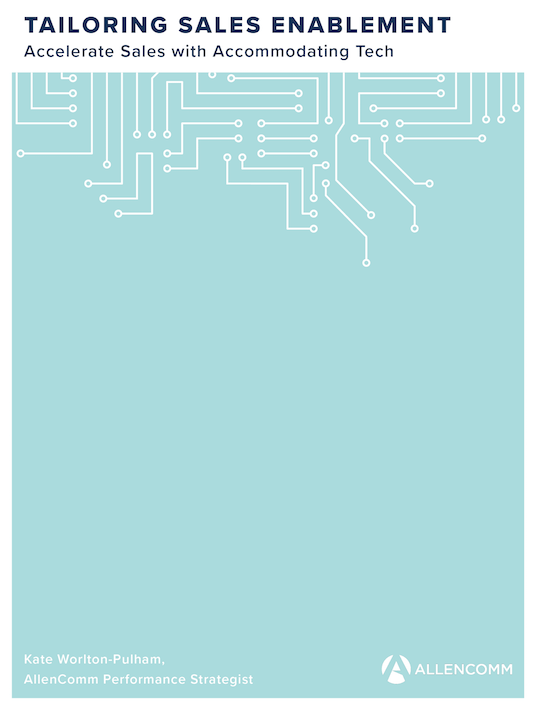What You Need To Know About Sales Enablement Training
Sales enablement boosts more than sales and marketing. If it’s a solution that is tailored to unique needs, it can lead to marked success for the entire organization. A needs analysis for sales enablement training shouldn’t necessarily recommend a new training model. It should instead tailor to your training model, whether that means leveraging your training strengths, turning your training challenges into opportunities, or both.

Performance Mapping
Performance mapping is the first step in sales enablement needs analysis and leads to learner training aimed at the organization’s desired business impact. The training is based on changing behaviors to a state that will accomplish the desired business goal and ensure increased revenue.
The analysis will consider questions like:
- Where does your sales process bottleneck?
- Where are the hotspots for improvement?
- How will we troubleshoot those areas?
- What should learners be thinking/feeling/ saying/doing?
Training could include seller onboarding, seller continuous learning, buyer-facing strategy, approach, and best practices, cross-departmental training among those in HR, L&D, R&D, and execs to enable sales. In our experience with sales enablement training, the needs analysis has usually recommended one or more of the following training components, each with a targeted case study and on-the-job behavior scenario.
5 Components Of Sales Enablement Training
1. Coaching
Sales coaching is born out of the widely accepted notion that all team members need established mentors who walk them through on-the-job scenarios with consistent, constructive, real-time feedback.
Coaching training is born out of the widely accepted fact that sales leaders have not necessarily been taught how to do this. While sales coaching training commonly involves mentor and communication development skills, AllenComm has learned from experience with firms in the finance, retail, IT, and food industries that all have unique needs and pressures with which to negotiate.
For instance, one client in the retail industry needed coaching training for sales managers with a spectrum of backgrounds and contexts that would factor into the desired behavior change. Accordingly, the web-based design provided a variety of real-life sales coaching scenarios aimed at various competency states with instructive feedback.
2. Just-In-Time
In just-in-time training, the immediate context of the specific learner governs the training design, whether that is for specific buying scenarios, seller training profiles, stakeholder personas, product updates, and, as a rule, for mobile (79% of sales field learners are using mobile training).
Sellers can waste a disheartening amount of time hunting for the right training, therefore the sales enablement needs analysis would advise which training should be served up to sellers at which specific stage of the buying process. While technology allows learners to pull training at will based on their self-identified needs, technology also allows training to be pushed to them, based on their preferences and searches. Because the training is tailored to their context, sellers also ramp up much faster. Accordingly, the training can be served up in micro bits, micromodules, with other microlearning features, as needed.
For a global electronics manufacturing leader, AllenComm assessed that their sellers needed to be enabled to diagnose complex technological problems and guide buyers through nuanced purchasing decisions and quickly all within a limited time frame. The best training for their sellers would be just-in-time web-based training micromodules, toolkits, motion graphics, and job aids that the sellers could consume on their mobile devices at a moment’s notice to use in the real world.
With a different client in the retail industry, our analysis taught us that they needed microbursts of training to enable retail managers and associates to build better relationships with customers. Together, we created a mobile-friendly micromodule platform with multiple simulated customer interactions. Gamification also played to the sellers’ strengths in a game where sellers practice asking questions that will match the customer to the right product.
3. Gamification
Gamification can resonate particularly with sellers, who are likely wired to thrive in a competitive environment. As an added bonus, gamification often necessitates score-keeping and recording, so it yields useful data which can feed into the organization’s performance reports.
With a client in the information technology industry, performance mapping told us that the organization’s 300,000+ employees needed to communicate one brand story. The gamification provided interactive decision points with immediate results, cognitive tasks that built results, and score pages with flexible performance results searches. The organization now benefits from the deeper alignment between sales and marketing and the ensuing uptick in win rates.
4. Third-Party External Training
Companies that provide sales training for other companies require the needs analysis to pay particular attention to how to cater to various audiences. While working with a global cloud delivery services company, AllenComm determined that in order to train their external network of partner sellers—a significant portion of this client’s revenue—the training needed to ensure that the learners could quickly deliver a joint value proposition and could cross-sell and up-sell the entire portfolio.
The client challenged AllenComm to develop training that would make complex material user-friendly and relevant for multiple external partners. The design included digital “cheat sheets” with product features and benefits, web-based training for five different sales roles, and interactive virtual sales simulations. The result is a conglomerate of partner sellers who are counting the benefits of now being able to expand the portfolio they can sell.
5. Brand
Brand training should be defined by identifying the buyer: whom the supplier serves and with what offering. When two or more organizations merge, the result can be a confluence of ideas, traditions, standards, practices, and interpretations of know-how. Subsequently, a new brand and messaging training can quickly become necessary.
In one such case with a client in the IT sector, a needs analysis by AllenComm revealed that when three organizations merged, the best method for brand training was to take the simplest route and offer a catalog of training options on the newly amalgamated brand. The catalog has categorized and scrollable brand training and tools menus with completion states. The outcome was a unified company with refreshed attitudes, adoptive of the new messaging and ready to innovate. Brand training also enables sales by allowing sellers to build their own brand story then practice how to share it in various buyer scenarios. For a client in the health foods organization, the training pathway gradually built sellers’ confidence and ownership over the value they personally offer.
Other Recommended Features Of Sales Enablement Training
Existing platforms can be maintained, added to, evolved, or revolutionized, as needed. AllenComm has worked with several clients in various industries who have had their own learner platform. We worked with their platform without compromising the functionality, brand, or learner experience. Likewise, existing curricula should be able to be updated and curated in terms of launching the sellers toward meeting the buyers’ changing business needs.
Automated assessments and certification speed the ramping process because sellers can be more readily aware of their aptitude and where improvements can be made. Because training should meet a specific business goal, assessments, while non-threatening and feedback-instructive, should be designed for competency, not just completion.
A needs analysis accepts the mandate to preserve the organization’s and the training’s scalability. In the case of a client who was a global auto manufacturer with tens of thousands of learners and several autonomously managed plants, each with its unique set of needs, the enablement design needed to allow for as few or as many plants chose to participate.
Likewise, the design needed to allow for many learner groups or just one learner group. The recommendation can scale to fit the client’s demand, scope, schedule, and specific context. It can scale big and involve the entire organization in a cultural shift initiative, or scale small and train just one group at one plant.
In sum, with these training methods and features, buyers will see your sales team members as trusted advisors and adjuncts to their goals, rather than just sales reps. If designed for impact, the training should move both the seller and buyer forward in tandem toward sale completion.
Stay tuned for our next article, where we’ll explore what you need to know about evaluating sales enablement technology.
If you want to learn more about sales enablement training programs, download the eBook Tailoring Sales Enablement: Accelerate Sales With Accommodating Tech.









